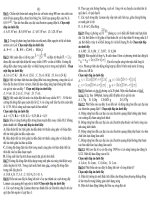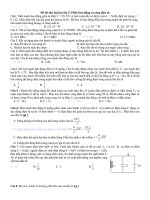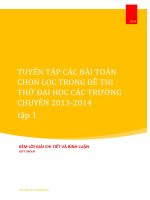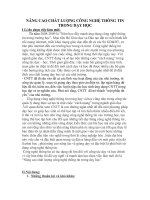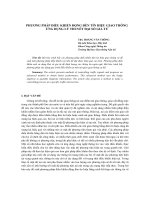CÁCH LÀM BÀI ĐỌC HIỂU TIẾNG ANH (SKILL 345)
Bạn đang xem bản rút gọn của tài liệu. Xem và tải ngay bản đầy đủ của tài liệu tại đây (155.74 KB, 10 trang )
SKILL 3. ANSWER STATED DETAIL QUESTIONS CORRECTLY
Example:
Williamsburg is a historic city in Virginia situated on a peninsula between two rivers, the York
and the James. It was settled by English colonists in 1633, twenty-six years after the first permanent
English colony in America was settled at Jamestown. In the beginning the colony at Williamsburg was
named Middle Plantation because of its location in the middle of the peninsula. The site for
Williamsburg had been selected by the colonists because the soil drainage was better there than at the
Jamestown location, and there were fewer mosquitoes.
1. According to the passage, Williamsburg
is located
(A) on an island
(B) in the middle of a river
(C) where the York and the James meet
(D) on a piece of land with rivers on two
sides
2. The passage indicates that Jamestown
(A) was settled in 1633
(B) was settled twenty-six years after
Williamsburg
(C) was the first permanent English colony
in America
(D) was originally named Middle Plantation
3. The passage states that the name Middle Plantation
(A) is a more recent name than Williamsburg
(B) derived from the location of the colony on the peninsula
(C) refers to the middle part of England that was home to the colonists
(D) was given to the new colony because it was located in the middle of several plantations
Exercises: Study each of the passages and choose the best answers to the questions that follow.
PASSAGE 1 (Questions 1-3)
Ice ages, those periods when ice covered extensive areas of the Earth, are known to have occurred at
least six times. Past ice ages can be recognized from strata that show evidence of foreign materials deposited
by moving walls of ice or melting glaciers. Ice ages can also be recognized from land formations that have
been produced from moving walls of ice, such as U-shaped valleys, sculptured landscapes, and polished
rock faces.
1. According to the passage, what happens
during an ice age?
(A) Rock strata are recognized by geologists.
(B) Evidence of foreign materials is found.
(C) Ice covers a large portion of the Earth’s
surface.
(D) Ice melts six times.
3. According to the passage, what in the rock
strata is a clue to geologists of a past ice age?
(A) Ice
(B) Melting glaciers
(C) U-shaped valleys
(D) Substances from other areas
2. The passage covers how many different
methods of recognizing past ice ages?
(A) One
(B) Two
(C) Three
(D) Four
NMG
Page 56
PASSAGE 2 (Questions 4-6)
The human heart is divided into four chambers, each of which serves its own function in the cycle of
pumping blood. The atria are thin-walled upper chambers than gather blood as it flows from the veins
between heartbeats. The ventricles are the thick-walled lower chambers that receive blood from the atria and
push it into the arteries with each contraction of the heart. The left atrium and ventricle work separately from
those on the right. The role of the chambers on the right side of the heart is to receive oxygen-depleted blood
from the body tissues and send it on the lungs; the chambers on the left side of the heart then receive the
oxygen-enriched blood from the lungs and send it back out to the body tissues.
4. The passage indicates that the ventricles
(A) have relatively thin walls
(B) send blood to the atria
(C) are above the atria
(D) force blood into the arteries
5. According to the passage, when is blood
pushed into the arteries from the ventricles?
(A) As the heart beats
(B) Between heartbeats
(C) Before each contraction of the heart
(D) Before it is received by the atria
6. According to the passage, which part of the
heart gets blood from the body tissue and
passes it on to the lungs?
(A) The atria
(B) The ventricles
(C) The right atrium and ventricle
(D) The left atrium and ventricle
PASSAGE 3 (Questions 7-9)
The Golden Age of Railroads refers to the period from the end of the Civil War to the beginning of
World War I when railroads flourished and in fact maintained a near monopoly in mass transportation in the
United States. One of the significant developments during the period was the notable increase in uniformity,
particularly through the standardization of track gauge and time.
At the end of the Civil War, only about half of the nation’s railroad track was laid at what is now the
standard gauge of 1, 4 meters; much of the rest, particularly in the southern states, had a 1.5-meter gauge.
During the postwar years, tracks were converted to the 1.4-meter gauge, and by June 1, 1886, the
standardization of tracks was completed, resulting in increased efficiency and economy in the rail system.
A further boon to railroad efficiency was the implementation of Standard Time in 1883. With the
adoption of Standard Time, four time zones were established across the country, thus simplifying railroad
scheduling and improving the efficiency of railroad service.
7. According to the passage, the Golden Age of
Railroads
(A) occurred to the prior to the Civil War
(B) was a result of World War I
(C) was period when most of U.S. mass
transportation was controlled by the
railroads
(D) resulted in a decrease in uniformity of
track gauge
8. The passage mentions that which of the
following occurred as a result of uniformity
of track gauge?
(A) The Civil War
(B) Improved economy in the transportation
system
(C) Standardization of time zones
(D) Railroad schedules
9. The passage indicates that Standard Time was implemented
(A) before the Civil War
(B) on June 1, 1886
(C) after World War I
(D) before standardized track gauge was established throughout the U.S.
NMG
Page 57
SKILL 4. FIND “UNSTATED” DETAILS
Example:
In English there are many different kinds of expressions that people use to give a name to
anything whose name is unknown or momentarily forgotten. The word gadget is one such word. It
was first used by British sailors in the 1850’s and probably came from the French word gachette, with
was a small hook. In everyday use, the word has a more general meaning. Other words are also used
to give a name to something unnamed or unknown, and these words tend to be somewhat imaginative.
Some of the more commonly used expressions are a what-d’ye-call-it, a whatsis, a thingamabob, a
thingamajig, a doodad, or a doohickey.
1. Which of the following is NOT true about
the word “gadget”?
(A) It is used to name something when the
name is not known.
(B) It was used at the beginning of the
nineteenth century.
(C) It most likely came from a word in the
French language.
(D) Its first known use was by British sailors.
2. Which of the following is NOT mentioned
in the passage as an expression for
something that is not known?
(A) A thingamabob
(B) A gadget
(C) A doohickey
(D) A what-is-it
Exercises: Study each of the passages and choose the best answers to the questions that follow.
PASSAGE 1 (Questions 1-2)
Blood plasma is a clear, almost colorless liquid. It consists of blood from which the red and while
blood cells have been removed. It is often used in transfusions because a patient generally needs the plasma
portion of the blood more than the other components.
Plasma differs in several important ways from whole blood. First of all, plasma can be mixed for all
donors and does not have to be from the right blood group, as whole blood does. In addition, plasma can be
dried and stored, while whole blood cannot.
1. All of the following are true about blood
plasma EXCEPT:
(A) It is deeply colored liquid.
(B) Blood cells have been taken out of it.
(C) Patients are often transfused with it.
(D) It is generally more important to the
patient than other parts of whole blood.
2. Which of the following is NOT stated about
whole blood?
(A) It is different from plasma.
(B) It cannot be dried.
(C) It is impossible to keep it in storage for a
long time.
(D) It is a clear, colorless liquid.
PASSAGE 2 (Questions 3-4)
Elizabeth Cochrane Seaman was an American journalist at the turn of the century who wrote for the
newspaper New York World under the pen name Nellie Bly, a name which was taken from the Stephen
Foster song Nelly Bly. She achieved fame for her exposes and in particular for the bold and adventuresome
way that she obtained her stories.
She felt that the best way to get the real story was from the inside rather than as an outside observer
who could be treated to a prettified version of reality. On one occasion she pretended to be a thief so that she
would get arrested and see for herself how female prisoners were really treated. On another occasion she
faked mental illness in order to be admitted to a mental hospital to get the real picture on the treatment of
mental patients.
3. Which of the following is NOT true about
Nellie Bly?
(A) Nellie Bly’s real name was Elizabeth
Cochrane Seaman.
(B) Nellie Bly was mentally ill.
(C) The name Nellie Bly came from a song.
(D) The name Nellie Bly was used on articles
that Seaman wrote.
4. Which of the following is NOT mentioned as
something that Nellie Bly did to get a good
story?
(A) She acted like a thief.
(B) She got arrested by the police.
(C) She pretended to be ill.
(D) She worked as a doctor in a mental
hospital
PASSAGE 3 (Questions 5-6)
Dekanawida’s role as a supreme lawgiver in the Iroquois tribe has given him the status of demigod
within the Indian nation. Born into the Huron tribe, Dekanawida caused great fear in his parents, who tried
to drown him in his youth after a prophecy was made indicating that he would bring great sorrow to the
Huron nation. Dekanawida was to survive this attempted drowning but later left parents’ home and tribe to
live among the Iroquois.
One of his achievements with the Iroquois was the institution of a law among the Iroquois that virtually
ended blood feuds among the nation’s families. Wampum, strings of beads made of polished shells, was a
valued commodity in the Iroquois culture; according to policies established by Dekanawida, wampum had to
be paid to the family of a murder victim by family of the killer.
Since the killer was also put to death, the
family of the killer had to pay the victim’s family in wampum for two deaths, the death of the murder victim
and the death of the killer. These strict policies implemented by Dekanawida helped to establish him as a
wise lawgiver and leader of the Iroquois nation.
5. According to the passage, Dekanawida was NOT:
(A) a lawmaker
(B) a Huron by birth
(C) a near deity
(D) drowned when he was young
6. Which of the following is NOT mentioned in the passage about wampum?
(A) It was used extensively by the Huron.
(B) It had a high value to the Iroquois.
(C) It was given to a murder victim’s family.
(D) It was made of polished shells
SKILL 5: FIND PRONOUN REFERENTS
Example:
Carnivorous plants, such as the sundew and the Venus-Flytrap, are generally found in humid areas
where there is an inadequate supply of nitrogen in the soil. In order to survive, these plants have
developed mechanisms to trap insects within their foliage. They have digestive fluids to obtain the
necessary nitrogen from the insects. These plants trap the insects in a variety of ways. The sundew has
sticky hairs on its leaves; when an insect lands on these leaves, it gets caught up in the sticky hairs, and
the leaf wraps itself around the insect. The leaves of the Venus-Flytrap function more like a trap,
snapping suddenly and forcefully shut around an insect.
1. The pronoun “they” in line 3 refers to:
(A) humid areas
(B) these plants
(C) insects
(D) digestive fluids
2. The pronoun “it” in line 5 refers to:
(A) a variety
(B) the sundew
(C) an insect
(D) the leaf
Exerxises: Study each of the passages and choose the best answer to the questions that follow.
PASSAGE 1 (Questions 1-2)
The full moon that occurs nearest the equinox of the Sun has become known as the Harvest Moon. It
is a bright moon which allows farmers to work late into the night for several nights; they can work when the
moon is at its brightest to bring in the fall harvest. The Harvest Moon of course occurs at the different times
of the year in the Northern and Southern Hemispheres. In the Northern Hemisphere, the Harvest Moon
occurs in September at the time of the autumnal equinox. In the Southern Hemisphere, the Harvest Moon
occurs in March at the time of the vernal equinox.
1. The pronoun “It” in line 1 refers to
(A) The equinox
(B) The Sun
(C) The Harvest Moon
(D) The night
2. The pronoun “they” in line 2 refers to
(A) farmers
(B) nights
(C) times of the year
(D) Northern and Southern
Hemispheres
PASSAGE 2 (Questions 3-4)
Mardi Gras, which means “Fat Tuesday” in French, was introduced to America by French colonists
in the early eighteen century. From that time it has grown in popularity, particularly in
New Orleans, and today it is actually a legal holiday in several southern states. The Mardi Gras celebration
in New Orleans begins well before the actual Mardi Gras Day. Parades, parties, balls, and numerous
festivities take place throughout the week before Mardi Gras Day; tourists from various countries throughout
the world flock to New Orleans for the celebration, where they take part in a week of nonstop activities
before returning home for some much-needed rest.
3. The pronoun “it” in line 2 refers to
(A) Mardi Gras
(B) French
(C) that time
(D) New Orleans
4. The pronoun “they” in line 6 refers to
(A) numerous festivities
(B) tourists
(C) various countries
(D) nonstop activities
PASSAGE 3 (Questions 5-6)
The financial firm Dow Jones and Company computes business statistics every hour on the hour of each
of the business days of the year, and these statistics are known as the Dow Jones averages. They are based
on a select group of stocks and bonds that are traded on the New York Stock Exchange. The Dow Jones
averages are composed of four different types of averages: the average price of the common stock of thirty
industrial firms, the average price of the common stock prices of twenty transportation companies the
average price of the common stock prices of fifteen utility companies, and an overall average of all the
sixty-five stocks used to compute the first three averages. Probably the average that is the most commonly
used is the industrial average; it is often used by an investor interested in checking the state of the stock
market before making an investment in an industrial stock.
5. The pronoun “They” in line 2 refers to
(A) the business days
(B) these statistics
(C) stocks and bonds
(D) four different types
6. The pronoun “it” in line 8 refers to
(A) the industrial average
(B) an investor
(C) the state of the stock market
(D) an investment
Review Skill 3 – 5: Study each of the passages and choose the best answer to the questions that follow.
PASSAGE 1 (Questions 1-4)
The United States does not have a national university, but the idea has been around for quite some time.
George Washington first recommended the idea to Congress; he even selected an actual site in Washington,
D.C., and then left an endowment for the proposed national university in his will. During the century
following the Revolution, the idea of a national university continued to receive the support of various U.S.
presidents, and philanthropist Andrew Carnegie pursued the cause at the beginning of the present century.
Although the original idea has not yet been acted upon, it continues to be proposed in bills before Congress.
1. According to the passage, the national
university of the United States:
(A) has been around for a while
(B) does not exist
(C) is a very recent idea
(D) is an idea that developed during the
present century
2. The passage indicates that
Washington did NOT do which
following?
(A) He suggested the concept for a
university to Congress.
(B) He chose a location for the
university.
(C) He left money in his will for a
university.
(D) succeeded in establishing a
university
George
of the
national
national
3. Which of the following is NOT mentioned in
the passage about Andrew Carnegie?
(A) He was interested in doing charity work
and good deeds for the public.
(B) He was a member of Congress.
(C) He was interested in the idea of a national
university.
(D) He was active in the early twentieth
century.
4. The pronoun “it” in line 6 refers to:
(A) the cause
(B) the beginning of the present century
(C) the original idea
(D) Congress
national
national
PASSAGE 2 (Questions 5-9)
The La Brea tarpits, located in Hancock Park in the Los Angeles area, have proven to be an
extremely fertile source of Ice Age fossils. Apparently, during the period of the Ice Age, the tarpits were
covered by shallow pools of water; when animals came there to drink, they got caught in the sticky tar and
perished. The tar not only trapped the animals, leading to their death, but also served
as a remarkably effective preservant, allowing near-perfect skeletons to remain hidden until the present era.
In 1906, the remains of a huge prehistoric bear discovered in the tarpits alerted archeologists to the
potential treasure lying within the tar. Since then thousand and thousands of well-preserved skeletons have
been uncovered, including the skeletons of camels, horses, wolves, tigers, sloths, and dinosaurs.
5. Which of the following is NOT true about the
La Brea tarpits?
(A) They contain fossils that are quite old.
(B) They are found in Hancock Park.
(C) They have existed since the Ice Age.
(D) They are located under a swimming pool.
6. The pronoun “they” in line 3 refers to
(A) the La Brea tarpits
(B) Ice Age fossils
(C) shallow pools of water
(D) animals
7. According to the passage, how did the Ice
Age animals die?
(A) The water poisoned them.
(B) They got stuck in the tar.
(C) They were attacked by other animals.
(D) They were killed by hunters.
8. When did archeologists become aware of the
possible value of the contents of the tarpits?
(A) During the Ice Age
(B) Thousands and thousands of years ago
(C) Early in the twentieth century
(D) Within the post decade
9. Which of the following is NOT mentioned as
an example of a skeleton found in the
tarpits?
(A) A bear
(B) A sloth
(C) A horse
(D) A snake
PASSAGE 3 (Questions 10-14)
When the president of the United States wants to get away from the hectic pace in Washington, D.C.,
Camp David is the place to go. Camp David, in a wooded mountain area about 70 miles from Washington,
D.C., is the official retreat of the president of the United States. It consists of living space for the president,
the first family, and the presidential staff as well as sporting and recreational facilities.
Camp David was established by President Franklin Delano Roosevelt in 1942. He found the site
particularly appealing in that its mountain air provided relief from the summer heat of Washington and its
remote location offered a more relaxing environment than could be achieved in the capital city.
When Roosevelt first established the retreat, he called it Shangri-La, which evoked the blissful
mountain kingdom In James Hilton’s novel Lost Horizon. Later, President Dwight David Eisenhower
renamed the location Camp David after his grandson David Eisenhower.
Camp David has been used for a number of significant meetings. In 1943 during World War II,
President Roosevelt met there with Great Britain’s Prime Minister Winston Churchill. In 1959 at the height
of the Cold War, President Eisenhower met there with Soviet Premier Nikita Khrushchev; in 1978 President
Jimmy Carter sponsored peace talks between Israel’s Prime Minister Menachem Begin and Egypt’s
President Anwar el-Sadat at the retreat at Camp David.
10. When of the following is NOT discussed
about Camp David?
(A) Its location
(B) Its cost
(C) Its facilities
(D) Its uses
11. According to the passage, who founded Cam
David?
(A) George Washington
(B) The first family
(C) Franklin Delano Roosevelt
(D) Dwight David Eisenhower
12. The pronoun “he” in line 8 refers to
(A) Camp David
(B) Roosevelt
(C) James Hilton
(D) President Dwight David Eisenhower
(E)
13. Which of the following is NOT true about
President Eisenhower?
(A) He had a grandson named David.
(B) He attended a conference with Nikita
Khrushchev.
(C) He named the presidential retreat ShangriLa.
(D) He visited was Camp David.
(B) 1943
(C) 1959
(D) 1978
14. Khrushchev was at Camp David in
(A) 1942
Review Skill 1 – 5: Study each of the passage and choose the best answer to the question that follow.
PASSAGE 1 (Question 1-4)
Hay fever is a seasonal allergy to pollens; the term “hay fever,” however, is a less than adequate
description since an attack of this allergy does not incur fever and since such an attack can be brought on by
sources other than hay-producing grasses. Hay fever is generally caused bay air-borne pollens, particularly
ragweed pollen. The amount of pollen in the air is largely dependent on geographical location, weather, and
season. In the eastern section of the United States, for example, there are generally three periods when
pollen from various sources can cause intense hay fever suffering: in the springtime months of March and
April when pollen from trees is prevalent, in the summer months of June and July when grass pollen fills the
air, and at the end of August when ragweed pollen is at its most concentrated levels.
1. Which of the following would be the best title
for the passage?
(A) The Relationship between Season and
Allergies
(B) Misconceptions and Facts about Hay Fever
(C) Hay Fever in the Eastern U.S.
(D) How Ragweed Causes Hay Fever
3. Which of the following is NOT discussed in
the passage as a determining factor of the
amount of pollen in the air?
(A) Place
(B) Climate
(C) Time of year
(D) Altitude
2. According to the passage, which of the
following helps to explain why the term “hay
fever” is somewhat of a misnomer?
(A) A strong fever occurs after an attack.
(B) The amount of pollen in the air depends on
geographical location.
(C) Hay fever is often caused by ragweed
pollen.
(D) Grass pollen is prevalent in June and July.
4. Which of the following is NOT true about
hay fever in the eastern U.S.?
(A) Suffering from hay fever is equally severe
year-round.
(B) Pollen from trees causes hay fever
suffering in the spring.
(C) Grass pollen fills the air earlier in the year
than ragweed pollen.
(D) Ragweed pollen is most prevalent at
the end of the summer.
PASSAGE 2 (Questions 5-9)
Lincoln’s now famous Gettysburg Address was not, on the occasion of its delivery, recognized as the
masterpiece that it is today. Lincoln was not even the primary speaker at the ceremonies, held at the height
of the Civil War in 1863, to dedicate the battlefield at Gettysburg. The main speaker was orator Edward
Everett, whose two-hour speech was followed by Lincoln’s shorter remarks. Lincoln began his small portion
of the program with the words that today are immediately recognized by most Americans: “Four score and
seven years ago our fathers brought forth on this continent a new nation, conceived in liberty and dedicated
5. the
to
This
proposition
main idea that
of this
all passage
men created
is that:
equal.” At the 7.
timeAccording
of the speech,
to thelittle
passage,
noticewhen
was Lincoln
given tospoke
what
Lincoln
(A) the
hadGettysburg
said, and Lincoln
Addressconsidered
has always
his appearance
been
at the Gettysburg
ceremonies ceremonies:
rather unsuccessful. After his
speech regarded
appeared as
in aprint,
masterpiece
appreciation for his words began (A)
to grow,
his words
and today
were immediately
it is recognized
recognized
as one of
bythe
all-time
(B) greatest
at the time
speeches.
of its delivery the Gettysburg
most Americans
Address was truly appreciated as a
(B) he spoke for only a short period of time
masterpiece
(C) he was enthusiastically cheered
(C) It was not until after 1863 that Lincoln’s
(D) he was extremely proud of his performance
speech at Gettysburg took its place in history
(D) Lincoln is better recognized today than he 8. When did Lincoln’s Gettysburg Address begin
was at the time of his presidency
to receive public acclaim?
(A) After it had been published
6. Which of the following is true about the
(B) Immediately after the speech
ceremonies at Gettysburg during the Civil
(C) Not until the present day
War?
(D) After Lincoln received growing recognition
(A) Lincoln was the main speaker.
(B) Lincoln gave two-hour speech.
9. The pronoun “it” in line 10 refers to which of
(C) Everett was the closing speaker of the
the following?
ceremonies.
(A) His speech
(D) Everett’s speech was longer than Lincoln’s
(B) Print
(C) Appreciation
(D) One
PASSAGE 3 (Questions 10-15)
According to the theory of continental drift, the continents are not fixed in position but instead move
slowly across the surface of the earth, constantly changing in position relative to one another. This theory
was first proposed in the eighteenth century when mapmakers noticed how closely the continents of the
earth fit together when they were matched up. It was suggested then that the present-day continents had
once been one large continent that had broken up into pieces which drifted apart.
Today the modern theory of plate tectonics has developed from the theory of continental drift. The
theory of plate tectonics suggests that the crust of the earth is divided into six large, and many small,
tectonic plates that drift on the lava that composes the inner core of the earth. These plates consist of ocean
floor and continents that quite probably began breaking up and moving relative to one another more than
200 million years ago.
10. The topic of this passage is
(A) continental drift
(B) the theory of plate tectonics
(C) the development of ideas about the
movement of the earth’s surface
(D) eighteenth-century mapmakers
11. The passage states that the theory of
continental drift developed as a result of
(A) the fixed positions of the continents
(B) the works of mapmakers
(C) the rapid movement of continents
(D) the fit of the earth’s plates
12. The pronoun “they” in line 4 refers to
(A) mapmakers
(B) continents
(C) pieces
(D) tectonic plates
13. Which of the following is NOT true about the
theory of plate tectonics?
(A) It is not as old as the theory of continental
drift.
(B) It evolved from the theory of continental
drift.
(C) It postulates that the earth’s surface is
separated into plates.
(D) It was proposed by mapmakers.
14. According to the passage, what constitutes a
tectonic plate?
(A) Lava
(B) Only the continents
(C) The inner core of the earth
(D) The surface of the land and this floor of
the oceans
15. Which of the following best describes the
organization of the passage?
(A) Two unrelated theories are presented.
(B) Two contrasting opinions are stated.
(C) A theory is followed by an example.
(D) One hypothesis is developed from another.


